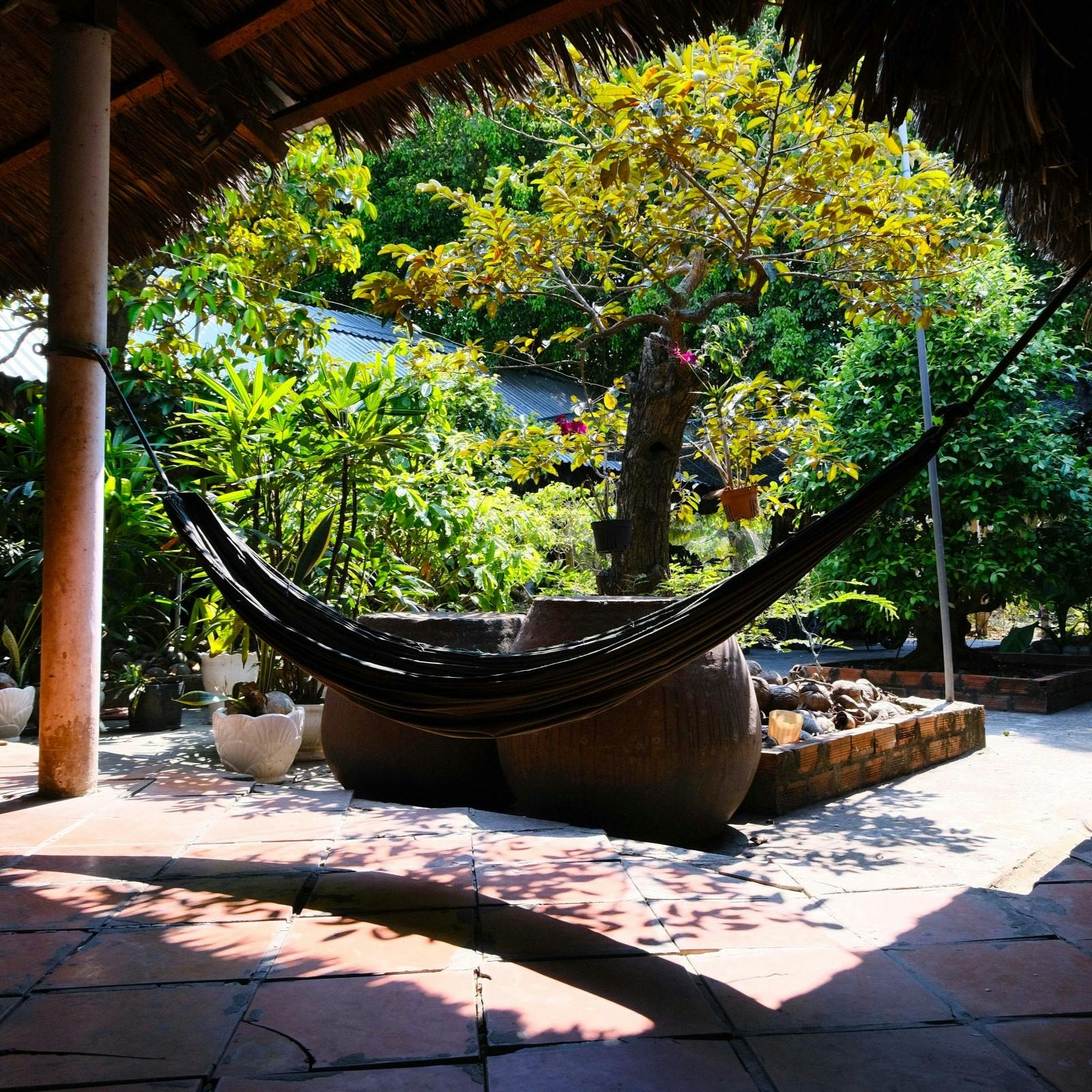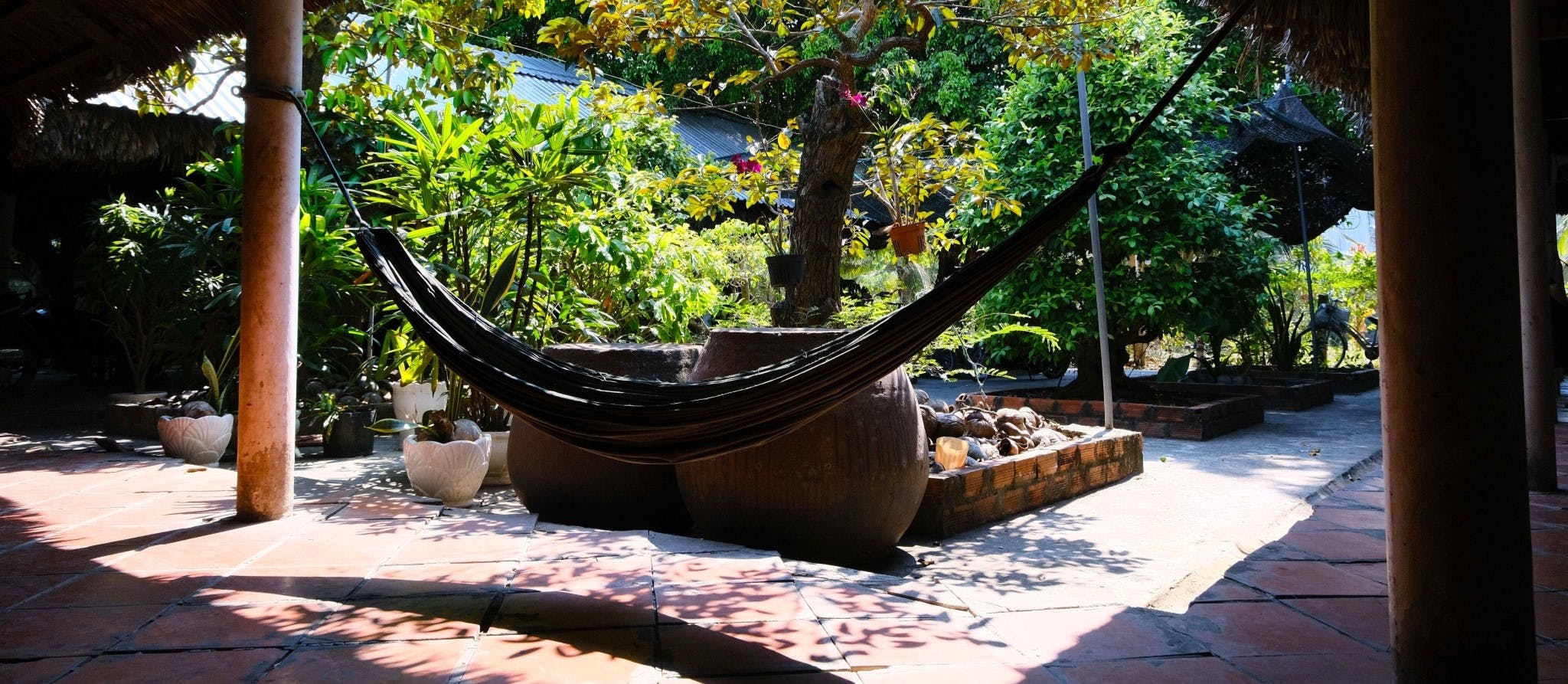First published May 2023 | Words and photos by Luke Digweed | 7 comments
Luke Digweed is a contributing writer for Vietnam Coracle. He has been living in Vietnam since 2011, mostly in Huế but also in Đà Nẵng & Sài Gòn. While living in Huế, he ran the Huế Grit Tour & co-organized events & small concerts between 2017-2020. His most recent ongoing project is Festivals of Vietnam which documents ceremonies, rituals & processions around the country….read more about Luke
When travelling from central to southern Vietnam, three things become apparent: the food gets sweeter, the topography flattens, and hammock cafes (cà phê võng) are in abundance. These variables all reach their zenith in the Mekong Delta. While I wouldn’t advocate for fewer mountain passes or sweeter food further up the country, I’d strongly lobby for the rest of Vietnam to adopt the hammock cafe culture of the southern regions.

[Back Top]
ODE TO HAMMOCK CAFES
A Practical, Affordable & Local Resource for Travellers
Hammock cafes are places to rest, drink, sleep, eat and take shelter when on the road. They are a valuable resource for long-distance travellers in Vietnam and at a price affordable to all. As well as being functional and practical, hammock cafes can be quirky, pretty or gritty; they can also be places of social interaction and sources of local knowledge. Every traveller should try at least one hammock cafe on their road trip in Vietnam.

CONTENTS:
Please Support Vietnam Coracle
Make a donation or become a patron if you enjoy this website. Vietnam Coracle is totally free & independent. I never receive payment for anything I write.
Thank you, Tom

What is a Hammock Cafe:
Hammock cafes, or ‘cà phê võng’, are roadside plots of land covered by roofing with hammocks pitched up in varying formations. Guests come for a reprieve from a long road trip; to lay down in a hammock and rest with a beverage. While some hammock cafes are indoors, the better ones are usually situated in an open-sided garden, allowing breezes to pass through and keep guests cool. Enthusiastic owners will keep their garden healthy and lush, decorated with plants and flowers, so that no matter how close to the road a guest is, they feel somewhat hidden from the outside world. However, many hammock cafes are purely functional with little attempt at decoration. There’s often a booth in the centre or to the side of hammock cafes where staff manage guests’ orders. But, you needn’t worry yourself about heading to the counter, because staff will usually come to serve you at your hammock.





Why Hammock Cafes are Great:
Hammock cafes are especially prevalent on big inter-provincial roads, but they can also be found on the outskirts of urban areas and rural backroads. Although hammock cafes do exist across the nation, they are especially common and popular in the southern provinces. They’re easy to spot thanks to large advertising boards that attempt to grab the attention of passersby with the words ‘Cà Phê Võng’ written in bold. If you’re feeling tired on a long-distance ride, hammock cafes offer an opportunity to grab a drink and put your feet up without having to rent a hotel room or lay down somewhere less comfortable.

Hammock cafes are cheap, too. Your stay comes at the expense of just one reasonably-priced drink and your time there is unlimited. Indeed, many guests take extended siestas at hammock cafes. Coffee, soft drinks, sugarcane (nước mía) and fresh coconuts are the drinks most commonly available. These are often on display for customers to see. Sometimes, hammock cafes serve food as well, or the owner collaborates with a nearby vendor to provide meals at your hammock.
Admittedly, hygiene at some hammock cafes isn’t of a high standard, but this isn’t meant to be a luxury travel experience: hammocks are affordable, available and welcome to all! Having said that, some hammock cafes – especially those with tiled flooring – require guests to take off their shoes before entering the premises, and almost all hammock cafes ask guests not to wear shoes while in their hammock.




When to Use a Hammock Cafe:
Hammock cafes are great places to stop for both long and short breaks from the road to give aching limbs a rest or to close your eyes for a short, rejuvenating nap. If you’re on a long ride on a hot and sunny day, a good time to stop and rest will be around noon, when the heat is at its most intense. Likewise, if you need somewhere to shelter during a heavy tropical downpour, what could be better than lying down in a hammock and listening to the syncopation of a rainstorm on a corrugated iron roof? Lastly, hammock cafes are good places to do some last-minute research en route to your destination. Indeed, staff and guests can be a good source of local knowledge.




How I Choose a Hammock Cafe:
I tend to make use of hammock cafes after a few hours of riding. When looking for one, I try not to divert too far from my route. Often, I’ll try to find one with a lot of plants or trees. If my possessions aren’t safe and secure on my motorbike, I’ll try to choose a place where I can park my bike nearby my hammock. If I’m near a river or the ocean, I’ll go a bit further off the main road to find a hammock cafe near the water’s edge, in the hope of catching a breeze. If I’m in a town or city and want to leave the chaos of a busy road, I’ll sometimes use Google Maps and type ‘cà phê võng’. Search results are never entirely accurate, but it can often save me time riding around streets without finding anything. On a main road in the Mekong Delta, you’re never more than a kilometre from a hammock cafe. It should be noted that bathroom facilities aren’t always very good, particularly at the more functional and economical hammock cafes. If this is a major ‘requirement’ of your stop, it’s best to check the toilet before you settle down for a drink and a rest.
While the majority of hammock cafes are honest establishments that facilitate rest and refreshment for weary travellers, there are some that exist as fronts for less savoury activities. These are easy to spot and avoid since they’re usually dark, dimly lit, indoor places, constructed so that the activities which take place inside are not visible from the outside. If you find yourself in the wrong kind of hammock cafe and realize you shouldn’t be there, don’t panic, just apologize and calmly leave.



*Disclosure: Vietnam Coracle content is always free and independent. Luke has written this guide because he wants to: he likes hammock cafes and he wants readers to know about them. For more details, see the Disclosure & Disclaimer statements and my About Page




Hi , loved the read, thanks.
Question : in one of the above photos there is a pile of green coconuts and next to it a pile of ….. what?
Something from a palm tree I think, but what are they used for or how are they consumed ?
Keep up the good work
Cheers
Hi Peter,
They are water coconuts – dừa nước in Vietnamese. The scientific name is Nypa fruticans: they are the fruit of the Nypa palm, which grows all over the Mekong Delta. Look up any of those names and you’ll find more information.
Best,
Tom
Thanks for the info and rapid reply.
Rgds
Peter
Hammock cafes are indeed one of the hidden-in-plain-sight wonders of Vietnam.
Thanks for a great article.
Agreed! Thanks, John 🙂
Tom
Heh, I wondering if you’d mention the less savoury ones. Honestly, even at those they are generally fine with you just resting there, in my experience.
One of my favourite parts of driving through Vietnam is just stopping at tiny roadside cafes every once in a while. We stopped at one in Phu Yen and the very old lady running it told us when she first moved to the area a very, very long time ago there were still tigers in the area and nobody left their house at night if they could avoid it.
Hi Justus,
Yes, stopping by a those hammocks cafes is a great part of riding around Vietnam, for sure: informal, practical, friendly, comfortable.
Best,
Tom